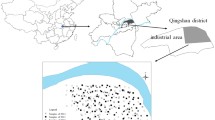Abstract
Both soil heavy metals and the influencing factors are related to spatial location and are spatially heterogeneous. However, the global linear regression model assumes the regression coefficients to be spatially stationary throughout the study region and is unable to account for the spatially varying relationships between soil heavy metals and influencing factors. Thus, the objectives of this study were to estimate the spatial distribution of soil heavy metals using a geographically weighted regression kriging (GWRK) approach, and compare the GWRK results with those obtained from ordinary kriging (OK) and regression kriging (RK). A dataset of soil lead (Pb) concentrations in Daye city, China, that was sampled in 2019 was used. According to the results of spatial smoothness, variability, and interpolation accuracy, GWRK was the best method and could provide the most reasonable spatial distribution pattern and the highest spatial interpolation accuracy in comparison with OK and RK.



Similar content being viewed by others
Data Availability
The datasets used and analyzed during the current study are available from the corresponding author on reasonable request.
References
Brunsdon C, Fotheringham AS, Charlton ME (1996) Geographically weighted regression: a method for exploring spatial nonstationarity. Geogr Anal 28(4):281–298
Chen W, Peng L, Hu K, Zhang Z, Peng C, Teng C, Zhou K (2020) Spectroscopic response of soil organic matter in mining area to Pb/Cd heavy metal interaction: a mirror of coherent structural variation. J Hazard Mater 393:122425
China National Environmental Monitoring Center (CNEMC) (1990) The background centrations of soil elements of China. China Environmental Science Press, Beijing, China
Fei X, Christakos G, Xiao R, Ren ZQ, Liu Y, Lv XN (2019) Improved heavy metal mapping and pollution source apportionment in Shanghai City soils using auxiliary information. Sci Total Environ 661:168–177
Guan QY, Zhao R, Wang FF, Pan NH, Yang LQ, Song N, Xu CQ, Lin JK (2019) Prediction of heavy metals in soils of an arid area based on multi-spectral data. J Environ Manag 243:137–143
Guo L, Ma Z, Zhang L (2008) Comparison of bandwidth selection in application of geographically weighted regression: a case study. Can J For Res-Revue Canadienne De Recherche Forestiere 38(9):2526–2534
Hua L, Yang X, Liu Y, Tan X, Yang Y (2018) Spatial distributions, pollution assessment, and qualified source apportionment of soil heavy metals in a typical mineral mining city in China. Sustainability 10(9):1–16
Kumar S, Lal R, Liu D (2012) A geographically weighted regression kriging approach for mapping soil organic carbon stock. Geoderma 189–190:627–634
Li C, Li F, Wu Z, Cheng J (2017) Exploring spatially varying and scale-dependent relationships between soil contamination and landscape patterns using geographically weighted regression. Appl Geogr 82:101–114
Ren J, Chen J, Han L, Wang M, Yang B, Du P, Li FS (2018) Spatial distribution of heavy metals, salinity and alkalinity in soils around bauxite residue disposal area. Sci Total Environ 628–629:1200–1208
Schwarz K, Pickett STA, Lathrop RG, Weathers KC, Pouyat RV, Cadenasso ML (2012) The effects of the urban built environment on the spatial distribution of lead in residential soils. Environ Pollut 163:32–39
Shen F, Liao R, Ali A, Mahar A, Guo D, Li R (2017) Spatial distribution and risk assessment of heavy metals in soil near a Pb/Zn smelter in Feng County, China. Ecotoxicol Environ Saf 139:254–262
Su SL, Xiao R, Zhang Y (2012) Multi-scale analysis of spatially varying relationships between agricultural landscape patterns and urbanization using geographically weighted regression. Appl Geogr 32(2):360–375
Wang HZ, Yilihamu Q, Yuan MN, Bai HT, Xu H, Wu J (2020) Prediction models of soil heavy metal(loid)s concentration for agricultural land in Dongli: A comparison of regression and random forest. Ecol Ind 119:106801
Yang Y, Zhang CT, Zhang RX (2016) BME prediction of continuous geographical properties using auxiliary variables. Stoch Environ Res Risk Assess 30:9–26
Yang Y, Yang X, He M, Christakos G (2020) Beyond mere pollution source identification: determination of land covers emitting soil heavy metals by combining PCA/APCS, GeoDetector and GIS analysis. CATENA 185:104297
Zhang H, Yin SH, Chen YH, Shao SS, Wu JT, Fan MM, Chen FR, Gao C (2020) Machine learning-based source identification and spatial prediction of heavy metals in soil in a rapid urbanization area, eastern China. J Clean Prod 273:122858
Zheng SN, Wang Q, Yu HY, Huang XZ, Li FB (2020) Interactive effects of multiple heavy metal(loid)s on their bioavailability in cocontaminated paddy soils in a large region. Sci Total Environ 708:135126
Zhu Q, Lin HS (2010) Comparing ordinary kriging and regression kriging for soil properties in contrasting landscapes. Pedosphere 20(5):594–606
Funding
This research was supported by the National Natural Science Foundation of China (Grant No. 42077378), and the National Key R&D Program of China (Grant No. 2018YFC1800104).
Author information
Authors and Affiliations
Corresponding author
Ethics declarations
Conflict of interest
The authors declare that they have no competing interests.
Additional information
Publisher’s Note
Springer Nature remains neutral with regard to jurisdictional claims in published maps and institutional affiliations.
Supplementary Information
Below is the link to the electronic supplementary material.
Rights and permissions
About this article
Cite this article
Fu, P., Yang, Y. & Zou, Y. Prediction of Soil Heavy Metal Distribution Using Geographically Weighted Regression Kriging. Bull Environ Contam Toxicol 108, 344–350 (2022). https://doi.org/10.1007/s00128-021-03405-2
Received:
Accepted:
Published:
Issue Date:
DOI: https://doi.org/10.1007/s00128-021-03405-2




